
A. a few firms producing identical goods.
B. many firms producing goods that differ somewhat.
C. a few firms producing goods that differ somewhat in quality.
D. many firms producing identical goods.
Correct: D
2. In a perfectly competitive industry, there are
A. many buyers and many sellers.
B. many sellers, but there might be only one or two buyers.
C. many buyers, but there might be only one or two sellers.
D. one firm that sets the price for the others to follow.
Correct: A
3. In perfect competition, the product of a single firm
A. is sold to different customers at different prices.
B. has many perfect complements produced by other firms.
C. has many perfect substitutes produced by other firms.
D. is sold under many differing brand names.
Correct: C
4. In perfect competition, restrictions on entry into an industry
A. do not exist.
B. apply to labor but not to capital.
C. apply to both capital and labor.
D. apply to capital but not to labor.
Correct: A
5. In perfect competition,
A. there are significant restrictions on entry.
B. each firm can influence the price of the good.
C. there are few buyers.
D. all firms in the market sell their product at the same price.
Correct: D
6. The price elasticity of demand for any particular perfectly competitive firm’s output is
A. less than 1.
B. equal to zero.
C. infinite.
D. 1.
Correct: C
7. The demand for wheat from farm A is perfectly elastic because wheat from farm A is a(n)
A. perfect complement to wheat from farm B.
B. perfect substitute for wheat from farm B.
C. normal good.
D. inferior good.
Correct: B
8. In perfect competition, the elasticity of demand for the product of a single firm is
A. 0.
B. infinite.
C. 1.
D. between 0 and 1.
Correct: B
9. In perfect competition, the elasticity of demand for the product of a single firm is
A. infinite, because many other firms produce identical products.
B. zero, because many other firms produce identical products.
C. zero, because the firm produces a unique product.
D. infinite, because the firm produces a unique product.
Correct: A
10. In perfect competition, an individual firm
A. has a price elasticity of supply equal to one.
B. faces unitary elasticity of demand.
C. has a price elasticity of supply equal to infinity.
D. faces infinitely elastic demand.
Correct: D
11. If Steve’s Apple Orchard, Inc. is a perfectly competitive firm, the demand for Steve’s apples has
A. elasticity equal to the price of apples.
B. unitary elasticity.
C. infinite elasticity.
D. zero elasticity.
Correct: C
12. In a perfectly competitive industry, the price elasticity of demand for the market demand is ________ and the price elasticity of demand for an individual firm’s demand is ________.
A. infinite; less than infinite
B. infinite; infinite
C. less than infinite; less than infinite
D. less than infinite; infinite
Correct: D
13. A perfectly competitive firm’s demand curve is
A. perfectly inelastic.
B. the same as the market demand curve.
C. downward sloping.
D. the same as the firm’s marginal revenue curve.
Correct: D
14. The market for fish is perfectly competitive. So, the price elasticity of demand for fish from a single fishery
A. is sometimes greater than and sometimes less than the elasticity of demand for fish overall.
B. is greater than the elasticity of demand for fish overall.
C. is less than the elasticity of demand for fish overall.
D. equals the elasticity of demand for fish overall.
Correct: B
15. In perfect competition, the price of the product is determined where the industry
A. elasticity of supply equals the industry elasticity of demand.
B. supply curve and industry demand curve intersect.
C. fixed cost is zero.
D. average variable cost equals the industry average total cost.
Correct: B
16. Economists assume that a perfectly competitive firm’s objective is to maximize its
A. revenue.
B. economic profit.
C. output price.
D. quantity sold.
Correct: B
17) Total economic profit is
A. total revenue minus total opportunity cost.
B. marginal revenue minus marginal cost.
C. total revenue divided by total cost.
D. marginal revenue divided by marginal cost.
Correct: A
18) The economic profit of a perfectly competitive firm
A. is less than its total revenue.
B. is greater than its total revenue.
C. equals its total revenue.
D. is less than its total revenue if its supply curve is inelastic and is greater than its total revenue if its supply curve is elastic.
Correct: A
19) In perfect competition, a firm that maximizes its economic profit will sell its good
A. below the market price.
B. above the market price.
C. below the market price if its supply curve is inelastic and above the market price if its supply curve is elastic.
D. at the market price.
Correct: D
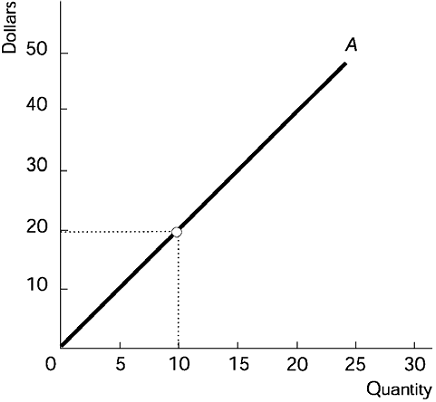
20) The above figure shows a firm’s total revenue line. The firm must be in a market with
A. monopolistic competition.
B. monopoly.
C. perfect competition.
D. oligopoly.
Correct: C
21) For a perfectly competitive firm, curve A in the above figure is the firm’s
A. average fixed cost curve.
B. average variable cost curve.
C. total revenue curve.
D. total fixed cost curve.
Correct: C
22. The figure above portrays a total revenue curve for a perfectly competitive firm. Curve A is straight because the firm
A. has perfect information.
B. wants to maximize its profits.
C. is a price taker.
D. faces constant returns to scale.
Correct: C
23. The figure above portrays a total revenue curve for a perfectly competitive firm. The firm’s marginal revenue from selling a unit of output
A. equals $1.00.
B. equals $2.00.
C. equals $0.50.
D. cannot be determined.
Correct: B
24. The figure above portrays a total revenue curve for a perfectly competitive firm. The price of the product in this industry
A. equals $1.00.
B. equals $2.00.
C. equals $0.50.
D. cannot be determined.
Correct: B
25. In the above figure showing a perfectly competitive firm’s total revenue line, the firm’s marginal revenue
A. does not change as output increases.
B. falls as output increases.
C. rises as output increases.
D. cannot be determined.
Correct: A

26. In the above table, if the firm sells 5 units of output, its total revenue is
A. $30.
B. $15.
C. $75.
D. $90.
Correct: C
27. In the above table, if the quantity sold by the firm rises from 5 to 6, its marginal revenue is
A. $15.
B. $75.
C. $90.
D. $30.
Correct: A
28. In the above table, if the quantity sold by the firm rises from 6 to 7, its marginal revenue is
A. $90.
B. $30.
C. $105.
D. $15.
Correct: D
29. In perfect competition, the marginal revenue of an individual firm
A. equals the price of the product.
B. is positive but less than the price of the product.
C. exceeds the price of the product.
D. is zero.
Correct: A
30. In the case of a perfectly competitive firm, the
A. firm’s marginal revenue exceeds the price of the product.
B. change in the firm’s total revenue equals the price of the product multiplied by the change in quantity sold.
C. firm’s marginal revenue is less than average revenue.
D. price of the product falls sharply when the quantity the firm sells doubles.
Correct: B
31. In perfect competition, the firm’s marginal revenue curve
A. cuts its demand curve from above, going from left to right.
B. always lies below its demand curve.
C. cuts its demand curve from below, going from left to right.
D. is the same as its demand curve.
Correct: D
32. At a firm’s break-even point, definitely its
A. marginal revenue equals its average fixed cost.
B. marginal revenue equals its average variable cost.
C. total revenue equals its total opportunity cost.
D. marginal revenue exceeds its marginal cost.
Correct: C
33. When Sidney’s Sweaters, Inc. makes exactly zero economic profit, Sidney, the owner,
A. makes an income equal to his best alternative forgone income.
B. will boost output.
C. will shut down in the short run.
D. is taking a loss.
Correct: A
34. The break-even point is defined as occurring at an output rate at which
A. total cost is minimized.
B. total revenue equals total opportunity cost.
C. economic profit is maximized.
D. marginal revenue equals marginal cost.
Correct: B

35. In the above table, the price of the product is
A. $30.
B. $150.
C. $147.
D. $180.
Correct: A
36. In the above table, the firm
A. must be in a perfectly competitive industry, because its marginal revenue is constant.
B. cannot be in a perfectly competitive industry, because its short-run economic profits are greater than zero.
C. cannot be in a perfectly competitive industry, because its long-run economic profits are greater than zero.
D. must be in a perfectly competitive industry, because its marginal cost curve eventually rises.
Correct: A
37. In the above table, the marginal revenue from the fourth unit of output is
A. $180.
B. $147.
C. $150.
D. $30.
Correct: D
38) In the above table, if the firm produces 2 units of output, it will make an economic
A. loss of $60.
B. profit of $60.
C. loss of $9.
D. profit of $9.
Correct: C

39) In the above table, the firm’s total fixed cost of production is
A. $29.00.
B. $4.00.
C. $3.00.
D. $7.00.
Correct: B
40) In the above table, the average fixed cost at 4 units of output is
A. $4.80.
B. $4.70.
C. $1.00.
D. $4.50.
Correct: C
41) In the above table, the average variable cost at 2 units of output is
A. $4.00.
B. $2.00.
C. $1.00.
D. $4.80.
Correct: B

42) In the above figure, by increasing its output from Q1 to Q2, the firm
A. increases its profit.
B. increases its marginal revenue.
C. reduces its marginal revenue.
D. decreases its profit.
Correct: A
43) In the above figure, by increasing its output from Q2 to Q3, the firm
A. increases its marginal revenue.
B. reduces its marginal revenue.
C. decreases its profit.
D. increases its profit.
Correct: C
44) The above figure illustrates a firm’s total revenue and total cost curves. Which one of the following statements is FALSE?
A. At output Q1 the firm makes zero economic profit.
B. At an output above Q3 the firm incurs an economic loss.
C. Economic profit is the vertical distance between the total revenue curve and the total cost curve.
D. At output Q2 the firm incurs an economic loss.
Correct: D
45) The feature of the above figure that indicates that the firm is a perfectly competitive firm is the
A. fact that the total cost and total revenue curves are farthest apart at output is Q2.
B. shape of the total revenue curve.
C. fact that the total cost and total revenue curves cross twice.
D. shape of the total cost curve.
Correct: B
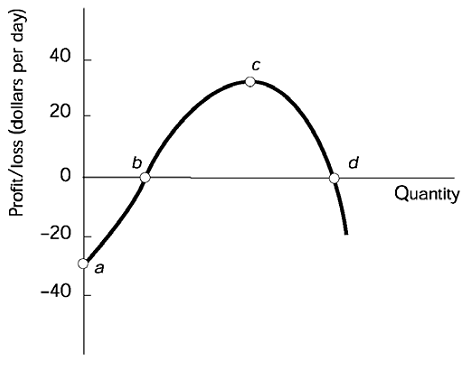
46) In the above figure, the firm is making an economic loss at
A. point a.
B. points b and d.
C. points a, b, and d.
D. point c.
Correct: A
47) In the above figure, the firm is breaking even at points
A. a and d.
B. b and d.
C. c and d.
D. a and c.
Correct: B
48) In the above figure, when the firm produces output corresponding to point c, the firm’s marginal cost
A. is less than its marginal revenue.
B. equals its average revenue.
C. exceeds its marginal revenue.
D. equals its marginal revenue.
Correct: D
49. For a perfectly competitive firm, in a diagram with quantity on the horizontal axis and both total revenue and total cost on the vertical axis, the firm’s ________ is a straight line ________.
A. total cost curve; through the origin
B. total revenue curve; with zero slope
C. total cost curve; with zero slope
D. total revenue curve; through the origin
Correct: D
50. A perfectly competitive firm maximizes its profit by producing the output at which its marginal cost equals its
A. average variable cost.
B. marginal revenue.
C. average total cost.
D. average fixed cost.
Correct: B
51. For a firm in perfect competition, a diagram shows quantity on the horizontal axis and both the firm’s marginal cost (MC) and its marginal revenue (MR) on the vertical axis. The firm’s profit-maximizing quantity occurs at the point where the
A. MC curve intersects the MR curve from above, going from left to right.
B. slope of the MC curve is zero.
C. MC curve intersects the MR curve from below, going from left to right.
D. MC and MR curves are parallel.
Correct: C
52. A firm will expand the amount of output it produces as long as its
A. average total revenue exceeds its average variable cost.
B. marginal revenue exceeds its marginal cost.
C. marginal cost exceeds its marginal revenue.
D. average total revenue exceeds its average total cost.
Correct: B
53. A perfectly competitive firm is producing at the point where its marginal cost equals its marginal revenue. If the firm boosts its output, its total revenue will ________ and its profit will ________.
A. fall; fall
B. fall; rise
C. rise; rise
D. rise; fall
Correct: D
54. A perfectly competitive firm is producing at the point where its marginal cost equals its marginal revenue. If the firm boosts its output, its revenue will
A. rise and its total variable cost will rise, but not by as much.
B. fall but its total variable cost will rise.
C. fall and its total variable cost will fall, but not by as much.
D. rise and its total variable cost will rise even more.
Correct: D
55. A perfectly competitive firm’s marginal revenue exceeds its marginal cost at its current output. To increase its profit, the firm will
A. increase its output.
B. raise its price.
C. decrease its output.
D. lower its price.
Correct: A
56. A perfectly competitive firm’s marginal cost exceeds its marginal revenue at its current output. To increase its profit, the firm will
A. increase its output.
B. raise its price.
C. lower its price.
D. decrease its output.
Correct: D
57. A perfectly competitive firm is producing more than the profit-maximizing amount of its product. You can conclude that its
A. marginal revenue is less than the price of the product.
B. total cost exceeds its total revenue.
C. average total cost exceeds the price of the product.
D. marginal cost exceeds the price of the product.
Correct: D
58. The costs incurred even when no output is produced are called
A. fixed costs.
B. external costs.
C. variable costs.
D. marginal costs.
Correct: A
59. A firm’s shutdown point is the quantity and price at which the firm’s total revenue just equals its
A. marginal cost.
B. total variable cost.
C. total cost.
D. total fixed cost.
Correct: B
60. It definitely pays a firm to shut down if the price of its product is
A. below its minimum average variable cost.
B. above its maximum variable cost.
C. above its minimum average variable cost.
D. below its minimum total cost.
Correct: A
61. The owners definitely will shut down a perfectly competitive firm if the price of its good falls below its minimumA. average marginal cost.
B. wage rate.
C. average variable cost.
D. average total cost.
Correct: C
62. A firm that shuts down and produces no output incurs a loss equal to its
A. marginal costs.
B. total fixed costs.
C. total variable costs.
D. marginal revenue.
Correct: B
63. By producing less, a firm can reduce
A. its variable costs but not its fixed costs.
B. its fixed costs and its variable costs.
C. its fixed costs but not its variable costs.
D. neither its variable costs nor its fixed costs.
Correct: A
64. The shutdown point occurs at the level of output for which the ________ is at its minimum.
A. marginal cost
B. total cost
C. average fixed cost
D. average variable cost
Correct: D
65. A competitive firm is more likely to shut down during a recession, when the demand for its product declines, than during an economic expansion, because during the recession it might be unable to cover its
A. external costs.
B. depreciation due to machinery becoming obsolete.
C. variable costs.
D. fixed costs.
Correct: C
66. If the price of its product falls below the minimum point on the AVC curve, the best a perfectly competitive firm can do is to
A. shut down and incur a loss equal to its total variable cost.
B. shut down and incur a loss equal to its total fixed cost.
C. keep producing and incur a loss equal to its total variable cost.
D. keep producing and incur a loss equal to its total fixed cost.
Correct: B
67. If the price of its product just equals the average variable cost of production for a competitive firm,
A. total revenue equals total variable cost and the firm’s loss equals total fixed cost.
B. total revenue equals total fixed cost and the firm’s loss equals total variable cost.
C. total variable cost equals total fixed cost.
D. total fixed cost is zero.
Correct: A
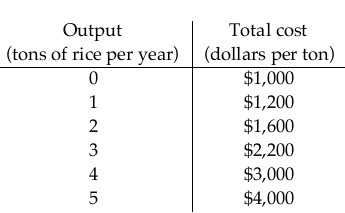
68. Based on the table above which shows Chip’s costs, if rice sells for $600 a ton, Chip’s profit-maximizing output is
A. less than one ton.
B. between one and two tons.
C. between two and three tons.
D. between three and four tons.
Correct: C
69. Based on the table above which shows Chip’s costs, if rice sells for $600 a ton, Chip will
A. stay open because he earns an economic profit.
B. stay open because the price is above his minimum average variable cost.
C. shut down because the price is below his minimum average variable cost.
D. shut down because he incurs an economic loss.
Correct: B
70. Based on the table above which shows Chip’s costs, if rice sells for $600 a ton, Chip
A. earns an economic profit, but should shut down in the short run.
B. incurs an economic loss, but should stay open in the short run.
C. incurs an economic loss and should shut down in the short run.
D. earns an economic profit and should stay open in the short run.
Correct: B
71. Based on the table above which shows Chip’s costs, if Chip shuts down in the short run, his total cost will be
A. $1,200.
B. $4,000.
C. $1,000.
D. $0.
Correct: C
72. Based on the table above which shows Chip’s costs, if Chip shuts down in the short run, his economic loss will be
A. $1,000.
B. $1,200.
C. $0.
D. $4,000.
Correct: A
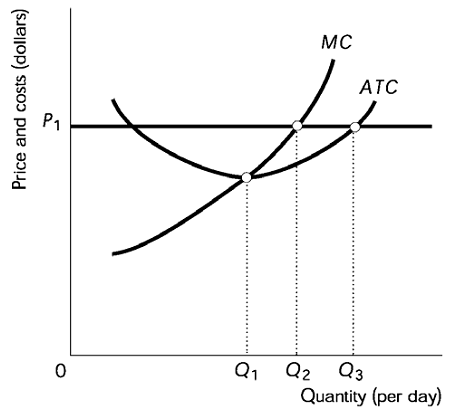
73. In the above figure, if the price is P1, the firm will produce
A. where ATC equals P1.
B. where MC equals P1.
C. nothing.
D. where MC equals ATC.
Correct: B
74. In the above figure, if the price is P1, the firm maximizes its profit by producing
A. where ATC equals P1.
B. nothing.
C. where MC equals P1.
D. where MC equals ATC.
Correct: C
75. In the above figure, if the firm increases its output from Q1 to Q2, it will
A. increase its profit.
B. reduce its marginal revenue.
C. decrease its profit.
D. increase its marginal revenue.
Correct: A
76. In the above figure, if the firm increases its output from Q2 to Q1, it will
A. reduce its marginal revenue.
B. increase its profit.
C. increase its marginal revenue.
D. decrease its profit.
Correct: D
77. In the above figure, if the price is P1, the firm is
A. incurring an economic loss.
B. shut down.
C. breaking even.
D. making an economic profit.
Correct: D
78. In the above figure, if the firm produced Q1, the firm’s economic profit is ________ than if it produced Q2 and ________ than if it produced Q3.
A. more; less
B. less; more
C. more; more
D. less; less
Correct: B
79. In the above figure, if the firm produced Q3, the firm’s economic profit is ________ than if it produced Q1 and ________ than if it produced Q2.
A. more; less
B. more; more
C. less; more
D. less; less
Correct: D
80) A perfectly competitive firm will have an economic profit of zero if, at its profit-maximizing output, its marginal revenue equals its
A. marginal cost.
B. average variable cost.
C. average total cost.
D. average fixed cost.
Correct: C

A. incur an economic loss.
B. earn an economic profit.
C. earn a normal profit.
D. None of the above answers is correct because more information is needed to determine the firm’s profit or loss.
Correct: A
82. The figure above shows short-run cost curves for a perfectly competitive firm. If the price of the product is $8 and the firm does not shut down, the firm’s output in the short run
A. will be 0.
B. will be 10 or higher.
C. will be between 0 and 10.
D. cannot be determined without more information.
Correct: C
83. The short-run supply curve for a perfectly competitive firm is its
A. marginal cost curve above the horizontal axis.
B. average cost curve above the horizontal axis.
C. average cost curve above its shutdown point.
D. marginal cost curve above its shutdown point.
Correct: D
84) The short-run supply curve for a perfectly competitive firm is its marginal cost curve
A. below its shutdown point.
B. above the horizontal axis.
C. everywhere.
D. above its shutdown point.
Correct: D
85) The short-run supply curve for a perfectly competitive firm is its marginal cost curve above the minimum point on the
A. average variable cost curve.
B. demand curve.
C. average total cost curve.
D. average fixed cost curve.
Correct: A
86) A perfectly competitive firm’s supply curve is made up of its marginal cost curve at all points above its minimum
A. average variable cost curve.
B. average total cost curve.
C. average fixed cost curve.
D. price.
Correct: A
87) The firm’s supply curve is its
A. marginal cost curve, at all points above the minimum average fixed cost curve.
B. marginal revenue curve, at all points above the minimum average total cost curve.
C. marginal cost curve, at all points above the minimum average variable cost curve.
D. marginal revenue curve, at all points above the minimum average revenue curve.
Correct: C
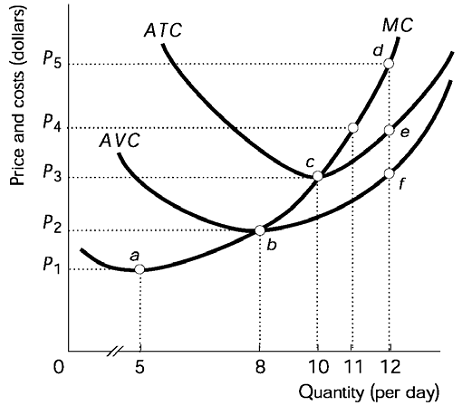
88) The figure represents a firm in a perfectly competitive market. The firm will shut down if price falls below
A. P2.
B. P1.
C. P3.
D. P4.
Correct: A
89) The figure represents a firm in a perfectly competitive market. If the firm does not shut down, the least amount of output that it will produce is
A. 10 units.
B. 8 units.
C. 5 units.
D. less than 5 units.
Correct: B
90. The figure represents a firm in a perfectly competitive market. If the price rises from P3 to P4 then output will increase by
A. 3 units.
B. 0 units.
C. 1 unit.
D. 2 units.
Correct: C
91. The figure above represents a firm in a perfectly competitive market. The firm’s supply curve is the curved line linking
A. point c to point e and continuing on past point e along the ATC curve.
B. point b to point f and stopping at point f.
C. point a to point c and stopping at point c.
D. point b to point d and continuing on past point d along the MC curve.
Correct: D
92. In a perfectly competitive industry, the industry supply curve is the sum of the
A. average total cost curves of all the individual firms.
B. supply curves of all the individual firms.
C. average variable cost curves of all the individual firms.
D. average fixed cost curves of all the individual firms.
Correct: B
93. If there are 1,000 rutabaga farms, all perfectly competitive, an increase in the price of fertilizer used for growing rutabagas will
A. have no effect on the total quantity of rutabagas supplied, because each farm’s supply curve is a vertical line.
B. reduce the total quantity of rutabagas supplied, because each farm’s supply curve is a horizontal line and will shift upward.
C. have no effect on the total quantity of rutabagas supplied, because no farm has enough market power to raise the price.
D. decrease the total quantity of rutabagas supplied, because each farm’s supply curve shifts leftward.
Correct: D

94. In the above figure, if the price is P1, the firm is
A. earning a normal profit.
B. incurring an economic loss.
C. earning enough revenue to pay all of its opportunity costs.
D. making an economic profit.
Correct: B
95. Suppose the cost curves in the above figure apply to all firms in the industry. Then, if the initial price is P1, in the long run the market
A. supply will decrease.
B. supply will increase.
C. demand will decrease.
D. demand will increase.
Correct: A
96. Suppose the cost curves in the above figure apply to all firms in the industry. If the initial price is P1, firms are
A. making an economic profit and some firms will leave the industry.
B. incurring an economic loss and some firms will leave the industry.
C. making an economic profit and some firms will enter the industry.
D. incurring an economic loss and some firms will enter the industry.
Correct: B
97. New reports indicate that eating turnips helps people remain healthy. The news shifts the demand curve for turnips rightward. In response, new farms enter the turnip industry. During the period in which the new farms are entering, the price of a turnip ________ and the profit of each existing firm ________.
A. falls; rises
B. rises; falls
C. rises; rises
D. falls; falls
Correct: D
98. If firms exit an industry, the
A. profits of the remaining firms decrease.
B. industry supply curve shifts leftward.
C. price of the product falls.
D. output of the industry increases.
Correct: B
99) As firms leave an industry because they are incurring an economic loss, the economic loss of each remaining firm
A. increases and the price of the product rises.
B. decreases and the price of the product falls.
C. decreases and the price of the product rises.
D. increases and the price of the product falls.
Correct: C
100) In a perfectly competitive industry, a permanent decrease in demand initially brings a lower price, economic
A. profit, and entry into the industry.
B. profit, and exit from the industry.
C. loss, and entry into the industry.
D. loss, and exit from the industry.
Correct: D
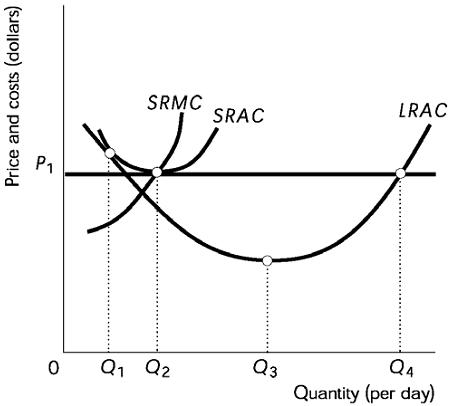
101) In the above figure, the firm’s initial average total cost curve is SRAC with an initial marginal cost curve of SRMC. The price of the product is P1. In the short run the firm will produce output equal to the amount
A. Q2.
B. Q1.
C. Q4.
D. Q3.
Correct: A
102) In the above figure, the firm’s initial average total cost curve is SRAC. If the price is P1., in the long run the firm will
A. retain the same plant size.
B. expand its plant size.
C. exit the industry.
D. reduce its plant size.
Correct: B
103) In the above figure when the firm has reached its long-run equilibrium position, it will produce output equal to the amount
A. Q4.
B. Q3.
C. Q2.
D. Q1.
Correct: B
104. If the cost curves shown in the above figure apply to all firms in the industry and the initial price is P1, in the long run the price will be
A. greater than P1.
B. zero.
C. equal to P1.
D. less than P1.
Correct: D
105. In a perfectly competitive industry, a permanent increase in demand initially brings a higher price, economic
A. profit, and entry into the industry.
B. profit, and exit from the industry.
C. loss, and entry into the industry.
D. loss, and exit from the industry.
Correct: A
106. In the long run, fixed costs are
A. zero and variable costs are zero.
B. zero and variable costs are positive.
C. positive and variable costs are positive.
D. positive and variable costs are zero.
Correct: B
107. In the long run, the economic profits of a firm in a perfectly competitive industry
A. will equal zero.
B. will be below zero.
C. will be above zero.
D. can be above, below, or equal to zero.
Correct: A
108. Assuming long-run external diseconomies exist, when demand increases in a perfectly competitive market, in the long run, the price of the product
A. falls below the initial price (before the increase in demand) and the quantity decreases.
B. equals the initial price (before the increase in demand) and the quantity increases.
C. equals the initial price (before the increase in demand) and the quantity decreases.
D. rises above the initial price (before the increase in demand) and the quantity increases.
Correct: D
109. Assuming long-run external economies exist, when demand increases in a perfectly competitive market, in the long run, the price of the product
A. rises above the initial price (before the increase in demand) and the quantity increases.
B. equals the initial price (before the increase in demand) and the quantity increases.
C. falls below the initial price (before the increase in demand) and the quantity increases.
D. equals the initial price (before the increase in demand) and the quantity decreases.
Correct: C
110. In a perfectly competitive market, if there are no external economies or diseconomies, an increase in demand
A. raises average cost in the long run.
B. lowers the price in the long run.
C. leaves the price the same in the long run.
D. raises the price in the long run.
Correct: C
111. If there are external economies, as demand increases,
A. output decreases in the long run.
B. the price falls in the long run.
C. the price rises in the long run.
D. firms exit from the industry in the long run.
Correct: B
112) External economies are factors beyond the control of an individual firm that ________ as the total industry output increases.
A. raise its marginal revenue
B. raise its costs
C. lower its costs
D. lower its profit
Correct: C
113) A long-run supply curve for a perfectly competitive industry can slope upward because of
A. external economies.
B. economic profit.
C. external diseconomies.
D. diminishing marginal returns.
Correct: C
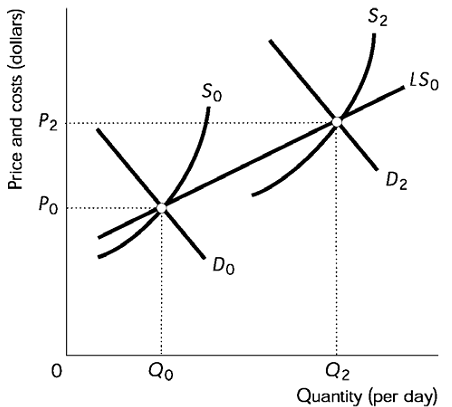
114) In the above figure, the industry short-run supply curve shifts from S0 to S2 as the
A. wage rate falls.
B. number of firms increases.
C. external economies rise.
D. number of firms decreases.
Correct: B
115) The curve LS0 in the above figure is the long-run supply curve of a perfectly competitive industry. As the demand curve shifts rightward, the industry exhibits
A. external economies.
B. neither external economies nor external diseconomies.
C. external diseconomies.
D. technological advancement.
Correct: C
116) Congestion of airports and airspace causes the airline industry to experience external
A. diseconomies and have a long-run supply curve with positive slope.
B. economies and have a long-run supply curve with positive slope.
C. diseconomies and have a long-run supply curve with negative slope.
D. economies and have a long-run supply curve with negative slope.
Correct: A
117. Assuming long-run external economies exist, when demand increases in a perfectly competitive market, in the long run the average total cost curve for a typical firm
A. shifts upward.
B. shifts downward.
C. is no longer U-shaped.
D. stays the same.
Correct: B
118. If the slope of the long-run supply curve for a perfectly competitive industry is positive, the industry experiences
A. internal economies.
B. external economies.
C. external diseconomies.
D. internal diseconomies.
Correct: C
119. If the slope of the long-run supply curve for a perfectly competitive industry is negative, the industry experiences
A. external economies.
B. external diseconomies.
C. internal diseconomies.
D. internal economies.
Correct: A
120. The gains from trade that go to households are called
A. consumer surplus.
B. income.
C. profits.
D. producer surplus.
Correct: A
121. Among the obstacles to the efficient allocation of resources are all of the following EXCEPTA. competition.
B. monopoly.
C. external benefits.
D. external costs.
Correct: A
122. An example of an external cost is
A. the damage created by a tornado.
B. pollution.
C. the price that a consumer pays for a new car.
D. the price that a firm pays for a consultant’s advice.
Correct: B
123. Which of the following characterizes a perfectly competitive industry?
A. Each firm produces a product slightly different from that of its competitors.
B. The industry demand curve is vertical.
C. The demand for each individual firm is perfectly elastic.
D. Each firm sets a different price.
Correct: C
124. Paul runs a shop that sells printers. Paul is a perfect competitor and can sell each printer for a price of $300. The marginal cost of selling one printer a day is $200; the marginal cost of selling a second printer is $250; and the marginal cost of selling a third printer is $350. To maximize his profit, Paul should sell
A. two printers a day.
B. more than three printers a day.
C. three printers a day.
D. one printer a day.
Correct: A
125. Because of a decrease in the wage rate it must pay, a perfectly competitive firm’s marginal costs decrease but its demand curve stays the same. As a result, the firm
A. decreases the amount of output it produces and lowers its price.
B. increases the amount of output it produces and lowers it price.
C. increases the amount of output it produces and does not change its price.
D. decreases the amount of output it produces and raises its price.
Correct: C
126. For prices above the minimum average variable cost, a perfectly competitive firm’s supply curve is
A. the same as its average variable cost curve.
B. horizontal at the market price.
C. the same as its marginal cost curve.
D. vertical at zero output.
Correct: C
127. A perfectly competitive firm is definitely earning an economic profit when
A. P > ATC.
B. P > AVC.
C. P < ATC.
D. MR < MC.
Correct: A
128. In the short run, a perfectly competitive firm can
A. earn a normal profit.
B. incur an economic loss.
C. earn an economic profit.
D. earn an economic profit, earn a normal profit, or incur an economic loss.
Correct: D
129. Suppose firms in a perfectly competitive industry are suffering an economic loss. Over time,
A. some firms leave the industry, so the price falls and the economic loss decreases.
B. some firms leave the industry, so the price rises and the economic loss decreases.
C. other firms enter the industry, so the price falls and the economic loss decreases.
D. other firms enter the industry, so the price rises and the economic loss decreases.
Correct: B
130. As firms enter a perfectly competitive industry,
A. the price falls and the existing firms’ economic profits do not change.
B. the price falls and the existing firms’ economic profits decrease.
C. the price falls and the existing firms’ economic losses do not change.
D. the price rises and the existing firms’ economic profits decrease.
Correct: B
131. In the long run, a perfectly competitive firm can
A. earn an economic profit, earn a normal profit, or incur an economic loss.
B. earn an economic profit.
C. incur an economic loss.
D. earn a normal profit.
Correct: D
132. The demand for a product produced in a perfectly competitive market permanently increases. In the short run the price
A. rises and each firm produces less output.
B. does not change because each firm produces more output.
C. rises and each firm produces more output.
D. does not change as new firms enter the industry.
Correct: C
133. If there are external diseconomies in an industry, in the long run, after a permanent increase in demand, the price
A. will be the same as it was initially before the increase in demand.
B. will be lower than it was initially before the increase in demand.
C. may be higher or lower than it was initially before the increase in demand, depending on whether or not the firms are earning an economic profit.
D. will be higher than it was initially before the increase in demand.
Correct: D
134. To which of the following situations does the term “external diseconomies” apply?
A. Increases in an industry’s output reduce the costs of the firms in an industry.
B. The firm’s ATC curve slopes upward as the firm produces more output.
C. The firm’s MC curve falls as more output is produced.
D. Increases in an industry’s output raise the costs of the firms in an industry.
Correct: D

135) The above figure shows the total revenue curve for Dizzy Discs. The demand curve for CD’s sold by Dizzy Discs
A. has positive slope.
B. has negative slope.
C. is horizontal.
D. is vertical.
Correct: C
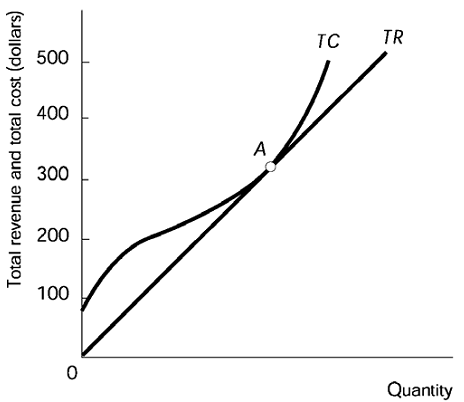
136) In the figure above, a firm is operating at point A on the graph. At point A, the firm’s average cost curve
A. is horizontal.
B. has negative slope.
C. is vertical.
D. has positive slope.
Correct: A
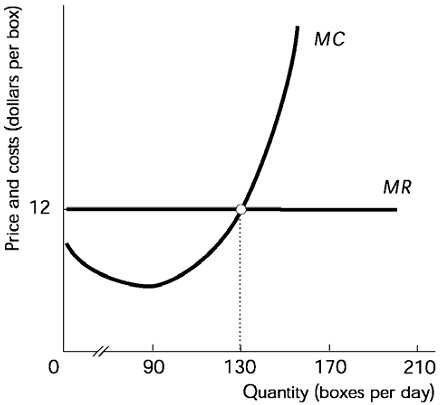
137) Carol’s Candies is producing 150 boxes of candy a day. Carol’s marginal revenue and marginal cost curves are shown in the figure above. To increase her profit, Carol should
A. decrease output to increase profit.
B. maintain the current level of output to maximize profit.
C. increase output to increase profit.
D. Not enough information is given to determine if Carol should increase, decrease, or not change her level of output.
Correct: A
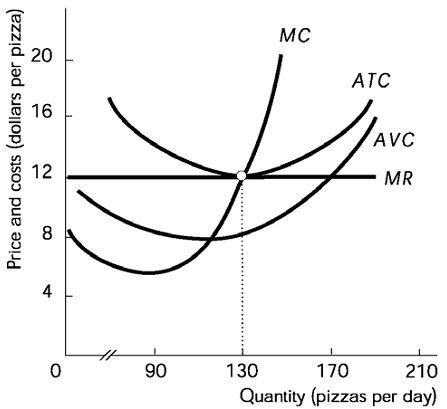
138) Joe’s Shiny Shoes is a firm that operates in a perfectly competitive market. The figure above shows Joe’s cost and revenue curves. If the number of firms in the shoe market decreases, Joe will
A. decrease his production.
B. have an MR curve with positive slope.
C. have an MR curve with negative slope.
D. increase his production.
Correct: D